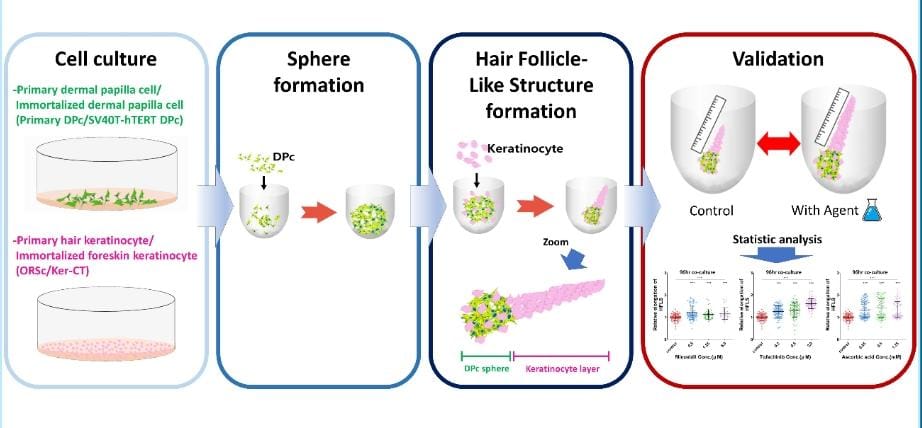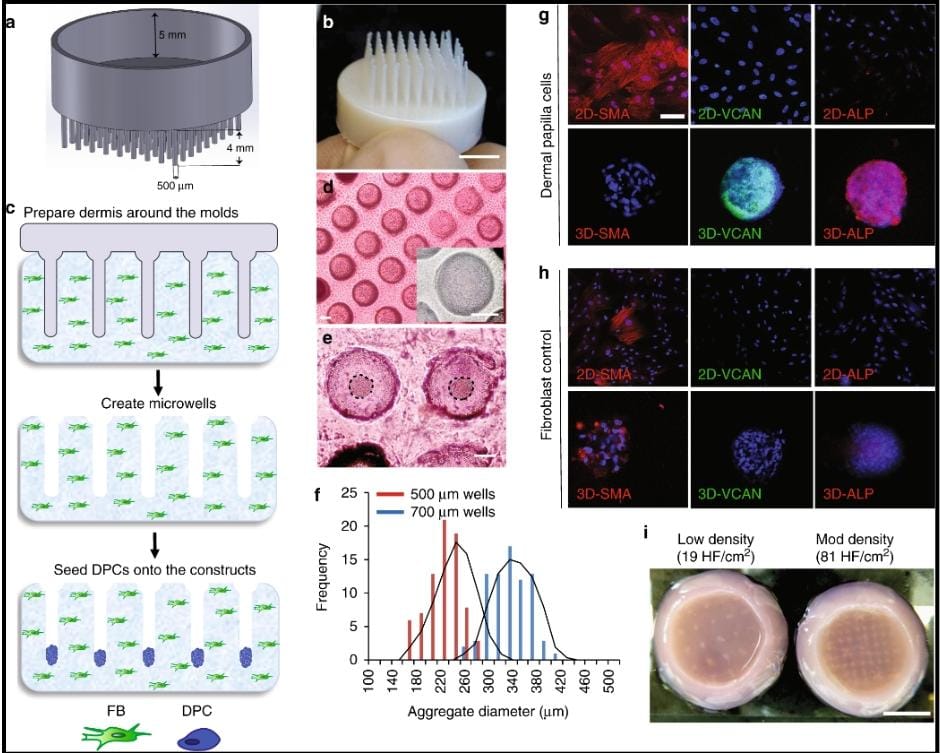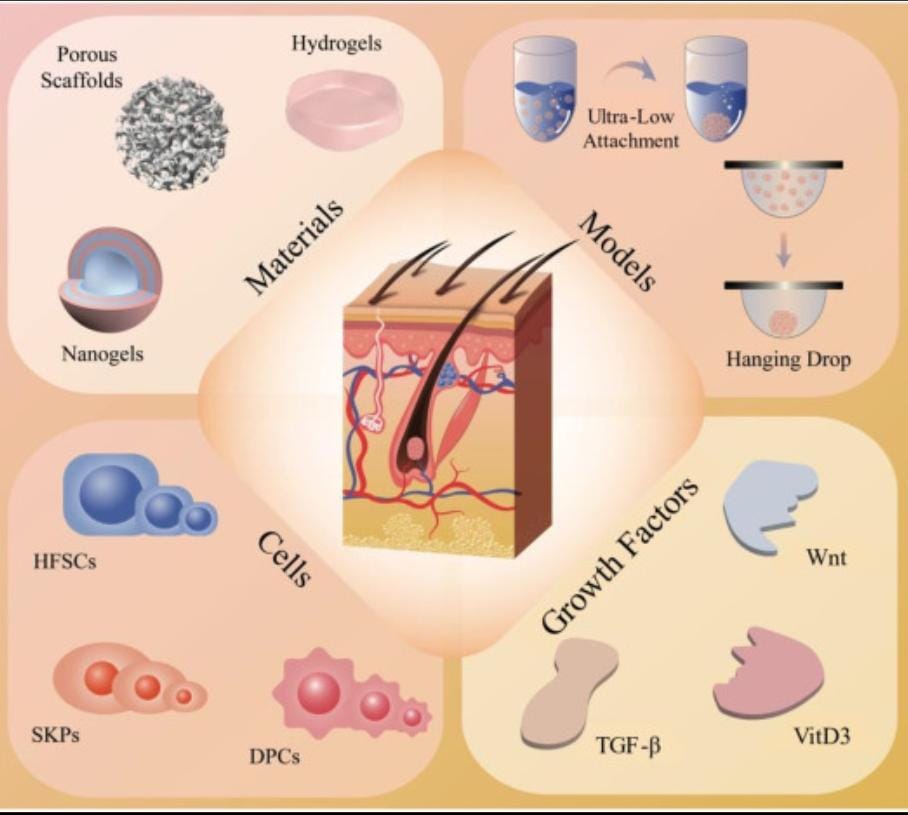Biomimetic Advances in Hair Follicle Studies

Introduction
The main goal of tissue-engineered skin transplants is to restore barrier function. The incapacity of several dermal-epidermal mixes or skin analogues to produce new skin structures like hair follicles has limited the use of these products in clinics.
Even while the ability to regenerate adult skin with functional skin attachments is presently a top therapeutic objective, the work of regrowing epidermal attachments, which includes hair follicles, oil glands, or sweat glands, is yet unfinished. (Abaci et al., 2018)

Research Study In Tissue Engineering:
Recent research has shown that adult mammalian skin contains multipotent stem cells that may regenerate hair follicles along with sebaceous glands and that these cells can maintain their multipotency in cell culture. Inductive dermal cells can trigger epidermal stem cells' capacity to differentiate into hair. (Chen et al., 2022)
The ability to successfully regenerate human hair follicles using tissue-engineered skin grafts has been demonstrated in immunodeficient mice and mice. It has not been documented that human hair can regenerate similarly, though. (Chen et al., 2022)
Current tissue-engineered epidermis grafts cannot replace skin appendages in healed wounds due to their low capacity to regenerate in individuals, the absence of adjunct components in the human skin implants, and maybe an unsuitable molecule environment.
There are still several approaches that should be investigated, especially concentrating inaccessible cells that possess trichogenic aptitude, retaining this competence throughout processing, and giving the cells with the right environmental cues. (Castro et al., 2020)

Limitations and Obstacles:
- One obstacle that has to be solved in tissue engineering is the reconstruction of completely functioning and organized follicles from fragmented cells generated using certain tissue culture environmental conditions.
- The psychological health of patients is impacted by the demise of hair follicles brought on by wounds or diseases like alopecia, but some essential skin functions are also put at risk. (Abaci et al., 2018)
- Finding new methods to regenerate and unregenerate a hair follicle under circumstances appropriate for an adult is therefore of significant interest.
- However, there hasn't yet been any viable method described for producing human hair follicles using adult cells. To accomplish this goal, a number of difficulties are identified in this review that should be taken into account. Creating three-dimensional culture conditions that mirror the shape of live tissue is arguably the biggest hurdle. (Castro et al., 2020)
Solutions:
- The challenges limiting human hair follicles neogenesis should be solved by improving conditions in culture that permit the growth of certain cells and maintaining the inductive capabilities, along with strategies for choosing populaces comprising epithelial cells.
- The amount of patent requests pertaining to follicle neogenesis and regeneration has grown over the past 10 years, according to an examination of patent trends. Researchers from academic institutions are drawn to this area, but so are the businesses that hold nearly half of the rights in it. (Balana et al., 2015)
Applications of Tissue Engineering:
There are a variety of compelling uses for tissue-engineered human HFs, including as:
(i) skin auxiliary treatment for full thickening skin damage,
(ii) hair renovation surgery,
(iii) replacing or enhancing animal copies of hair illness for medication discovery, and
(iv) evaluating beautifying items. (Abaci et al., 2018)
Challenges and Cell Sources in HF Bioengineering:
The potential for HF cloning, or the creation of bioengineered beneficial germs from human HF cells grown in vitro to produce fully functioning HFs upon transplant onto the patient's bald scalp, makes stem cell-based regenerative therapies the most successful approach for treating hair loss. There have been several documented techniques for employing hair follicle cells and tissues to test therapy options for hair follicle development. (Balana et al., 2015)
However, the need for assessing hair-promoting candidates cannot be met by the availability of hair from human beings follicle tissues for study, which are mostly derived from leftover hair follicles following autologous hair transplantation. Potential techniques have been disclosed that nearly imitate in vivo settings employing a 3D-cultured hairs follicle-like structure. (Castro et al., 2020)
The number of tests that may be carried out is constrained by these difficulties in obtaining enough hair follicle cells.

Discussion:
We proved that keratinocytes plus SV40T-hTERT DPc spheroids could work together to procedure the hair follicle structure, which then shrank down to a size resembling an in vivo dermis. The extent and quantity of cells within the cutaneous papilla affect hair development differently. (Abaci et al., 2018)
The scope of both invivo epidermal papilla and the cells in hair follicles vary depending on the hair cycles. These findings suggest that while producing HFLS using immortalized cells, the cells that make up the spheroids ought to be managed with adequate cell statistics to create spheroids in comparable magnitude for in vivo follicles papilla during the anagen stage. Our research also showed that the cell type affects how many cells are needed to generate a particular spheroid size. (Chen et al., 2022)
In comparison to DMEM or keratinocyte media for culture, the tissue culture media has the highest growth efficiency for iHFLS keratinocyte layers. These findings imply that a balanced diet, as opposed to nutrition tailored specifically for individual cell types, is more beneficial in promoting the proliferation of iHFLS. In the following research, known follicle development-related chemicals may be added to the culture media to influence the formation of follicle-like structures. (Chen et al., 2022)
Numerous research on subject of imitating follicles using in vitro setting have recently been published. This research, along with many others on hair follicle architecture neogenesis, has used techniques utilizing the multiple cellular, multilayered keratinocytes and cell spheroids. (Castro et al., 2020)
This approach benefits from research screening possible hair endorsing drugs after a broad complex since the methodology is straightforward.
Studies employing various methods to simulate hair follicles have also been described. These investigations share the objective of simulating in vivo circumstances around hair follicles utilizing a variety of methods, including controlling cell combinations, creating an in vivo cutaneous structure and employing additional bioactive chemicals. (Balana et al., 2015)
Our model may also be used to create disease copies and diagnostic exam procedures. We are certain if cutting-edge approach will satisfy the expanding need for the evaluation and screening of numerous potential participants in hair care research. (Abaci et al., 2018)
Conclusion:
This review summarizes recent developments in various experimental methods for regenerating or neogenerating hair like follicles, both in vitro and in vivo, with a focus on techniques like genesis of adult hair follicles that are detached cells through tissue engineering.
References
Chen, P., Miao, Y., Zhang, F., Fan, Z., Huang, J., Mao, X., ... & Wang, J. (2022). Tissue engineering ECM-enriched controllable vascularized human microtissue for hair regenerative medicine using a biomimetic developmental approach. Journal of Advanced Research, 38, 77-89.
Castro, A. R., & Logarinho, E. (2020). Tissue engineering strategies for human hair follicle regeneration: How far from a hairy goal?. Stem cells translational medicine, 9(3), 342-350.
Balañá, M. E., Charreau, H. E., & Leirós, G. J. (2015). Epidermal stem cells and skin tissue engineering in hair follicle regeneration. World journal of stem cells, 7(4), 711.

Company
Need Help?
Recruitment
Made in Europe ©2024 Skillmed

